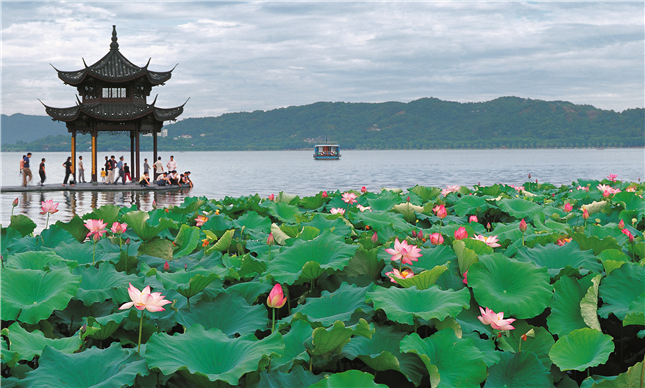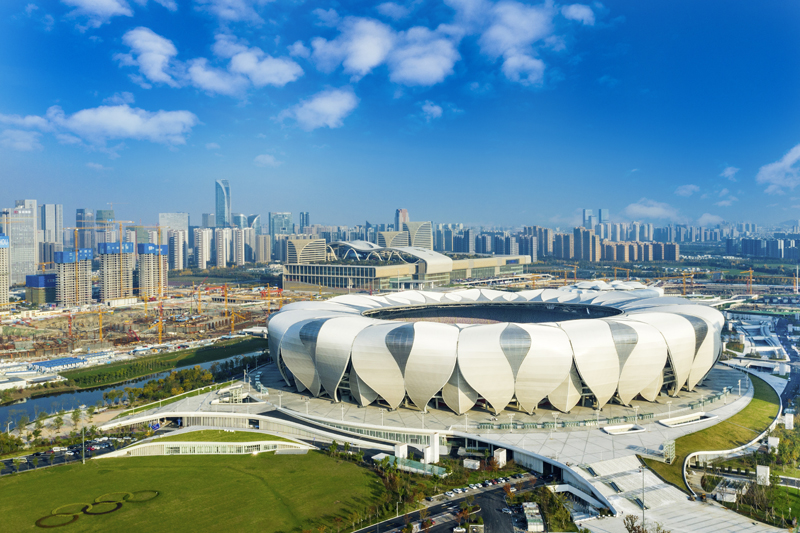A glimpse into Hangzhou

History
One of the birthplaces of Chinese civilization and ranking among the seven ancient capitals in China, Hangzhou stands out as the "Famous Town of Southeast China". The excavation of the Kuahu Bridge site located in the city's Xiaoshan district indicates that as early as 8,000 years ago the place already saw thriving human activities. The 5,000 year-old Liangzhu culture is hailed by historians as "the dawn of civilization". First set up as a county in the Qin Dynasty (221-206 BC), Liangzhu has a past of over 2,200 years. In the 9th year of Emperor Yang Jian, founder of the Sui Dynasty (581-618), the old Qiantang County (today's Hangzhou) was abolished and replaced by Hangzhou (Hang prefecture), marking the first appearance of its current name. Hangzhou was a marvel to 13th century Italian traveler Marco Polo who called it "the most graceful and splendid city of the world".
Economy
In 2019, Hangzhou saw stable economic growth with a gross domestic product (GDP) of 1.54 trillion yuan ($218.3 billion), a year-on-year increase of 6.8 percent.
The city saw robust growth in both its digital economy and manufacturing industry in 2019.
The above-scale industrial added value of the city was 353.1 billion yuan, a year-on-year increase of 15.1 percent. High-tech companies contributed nearly 61.7 percent of the city's total added value, 4.5 percentage points higher than last year.
The added value of core digital economy industries in Hangzhou last year was 379.5 billion yuan, a year-on-year increase of 15.1 percent.
The added value of the service industry in Hangzhou last year was 1.02 trillion yuan, the first time it has exceeded 1 trillion yuan. It accounted for 72.9 percent of the city's total GDP growth. The added value of the financial service industry was 179.1 billion yuan, a year-on-year increase of 9.1 percent.
In 2019, 22 new companies in Hangzhou went public, bringing the total number of listed companies in the city to 191, ranking fourth among Chinese cities.
The added value of the city's healthcare industry was 97.5 billion yuan, a year-on-year increase of 12.5 percent, while the added value of the cultural creation industry was 373.5 billion yuan, a year-on-year increase of 15.6 percent.
The per capita disposable income of Hangzhou permanent residents last year was 59,261 yuan, a year-on-year increase of 9 percent. In urban areas, the average was 66,068 yuan, a year-on-year increase of 8 percent, while for rural residents, it was 36.255 yuan, a year-on-year increase of 9.2 percent.
The public budget expenditure of Hangzhou last year was 195.3 billion yuan, a year-on-year increase of 13.7 percent, while expenditures on improving people's livelihood accounted for 78.6 percent of the general public budget.
Culture
Hangzhou boasts a long history and great cultural wealth. Its culture features the landmarks of the city, like West Lake, the Grand Canal and the Qiantang River and embraces integration and development in an open and innovative era.
The West Lake Culture absorbed the essence of local culture in different epochs, such as Kuahuqiao Culture, Liangzhu Culture that dates back to 3310 - 2250 BC, Wuyue Culture, and the cultures of the Southern Dynasty (1127-1279), Ming and Qing dynasties (1368 - 1644, 1644 - 1911) and the Minguo era (1912-1949).
West Lake Culture covers a wide range of elements, including landscape, gardening, religion, architecture, celebrities, folk customs, the Silk Road, tea and cuisine, all coming together in delicacy and harmony.
The Canal Culture, which integrates the specialties, waterscape, local opera and temple fairs, shows the openness, inclusiveness and popularity of Hangzhou Culture.
Qiantangjiang Culture is as magnificent as the tidal bore of the Qiantang River.
Geography & Climate
As the capital of Zhejiang province and its economic, cultural, science and educational center, Hangzhou is one of the central cities in the Yangtze River Delta. It also ranks among the first batch of National Historical and Cultural Towns crowned by the State Council.
Located in the southern wing of the Yangtze River Delta, at the western tip of Hangzhou Bay, it is the crossing point of the extension of the Silk Road Economic Belt and the 21st Century Maritime Silk Road, and a strategic hub along the Online Silk Road. Situated at the juncture of 29°11’-30°34' North and 118°20’-120°37' East, Hangzhou features a perfect blending of hills and water, and lakes and town, with its harmonious rich water resources of rivers, canals, lakes, sea, creeks. Hilly or mountain areas, largely concentrated in the west, middle and south, account for 65.6 percent of its territory. Its plains amount to 26.4 percent, mainly found in the northeast; and the surface area of rivers, lakes and reservoirs takes up 8.0 percent. Hangzhou boasts the largest reservoir in China's southern coast -- Qiandao Lake. Traversing the city is the world's longest artificial canal -- the Beijing-Hangzhou Grand Canal, and the Qiantang River, widely known for its spectacular tidal waves.
Hangzhou enjoys a subtropical monsoon climate with distinct seasons, ample sunlight and rainfall, more in spring and autumn and less in winter and summer.
Administrative Division
Under the jurisdiction of the city of Hangzhou are 10 urban districts, namely Shangcheng, Xiacheng, Jianggan, Gongshu, Xihu (West Lake), Binjiang, Xiaoshan, Yuhang, Fuyang, and Lin'an, one county-level city -- Jiande -- and the two counties of Tonglu, and Chun'an. Together they enclose a total of 190 towns (subdistricts), of which 23 are townships, 75 towns, 92 subdistricts, 1,072 communities, 34 residential quarters and 2,043 administrative villages. The city covers a total area of 16,596 square kilometers; 4,876 of them are urban.
-
Hangzhou's GDP reaches 1.61 trillion yuan in 2020
February 1, 2021
-
Year-ender: Hangzhou's vibrant market in 2020
January 26, 2021
-
Hangzhou the second-biggest populated city in YRD region
January 13, 2021
-
Indian in Hangzhou on beautiful holiday blessings
February 4, 2021



